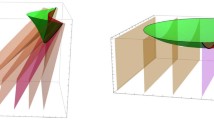Abstract
The steady withdrawal of an inviscid fluid of finite depth into a line sink is considered for the case in which surface tension is acting on the free surface. The problem is solved numerically by use of a boundary-integral-equation method. It is shown that the flow depends on the Froude number, F B=m(gH 3 B)−1/2, and the nondimensional sink depth λ=H S/H B, where m is the sink strength, g the acceleration of gravity, H B is the total depth upstream, H S is the height of the sink, and on the surface tension, T. Solutions are obtained in which the free surface has a stagnation point above the sink, and it is found that these exist for almost all Froude numbers less than unity. A train of steady waves is found on the free surface for very small values of the surface tension, while for larger values of surface tension the waves disappear, leaving a waveless free surface. It the sink is a long way off the bottom, the solutions break down at a Froude number which appears to be bounded by a region containing solutions with a cusp in the surface. For certain values of the parameters, two solutions can be obtained.
Similar content being viewed by others
References
J. Imberger and P. F. Hamblin, Dynamics of lakes, reservoirs and cooling ponds. Ann. Rev. Fluid Mech. 14 (1982) 153-187.
A. Craya, Theoretical research on the flow of nonhomogeneous fluids. La Houille Blanche 4 (1949) 44-55.
P. Gariel, Experimental research on the flow of nonhomogeneous fluids. La Houille Blanche 4 (1949) 56-65.
D. G. Huber, Irrotational motion of two fluid strata towards a line sink. J. Engng. Mech. Div. ASCE 86 (1960) 71-86.
G. C. Hocking, Withdrawal from two-layer fluid through line sink. J. Hydraulic Engng, ASCE 117 (1991) 800-805.
G. H. Jirka, Supercritical withdrawal from two-layered fluid systems-Part 1: Two-dimensional skimmer wall. J. Hydraulic Res. 17 (1979) 43-51.
Q.-N. Zhou and W. P. Graebel, Axisymmetric draining of a cylindrical tank with a free surface. J. Fluid Mech. 221 (1990) 511-532.
G. C. Hocking, Cusp-like free-surface flows due to a submerged source or sink in the presence of a flat or sloping bottom, J. Austr. Math. Soc.-Series B 26 (1985) 470-486.
G. C. Hocking, Critical withdrawal from a two-layer fluid through a line sink. J. Engng Math. 25 (1991) 1-11.
C. Sautreaux, Mouvement d'un liquide parfait soumis à la pesanteur. Détermination des lignes de courant. J. Math. Pures Appl. 5 (1901) 125-159.
E. O. Tuck and J. M. Vanden-Broeck, A cusp-like free-surface flow due to a submerged source or sink. J. Austr. Math. Soc.-Series B 25 (1984) 443-450.
J. M. Vanden-Broeck and J. B. Keller, Free surface flow due to a sink. J. Fluid Mech. 175 (1987) 109-117.
G. C. Hocking, Supercritical withdrawal from a two-layer fluid through a line sink. J. Fluid Mech. 297 (1995) 37-45.
J. M. Vanden-Broeck, Cusp flow due to a submerged source with a free surface partially covered by a lid. Eur. J. Mech. B (Fluids) 16 (1997) 249-255.
G. C. Hocking and J. M. Vanden-Broeck, Withdrawal of a fluid of finite depth through a line sink with a cusp in the free surface. Comp. Fluids 27 (1998) 797-806.
D. H. Peregrine, A Line Beneath a Free Surface. University of Wisconsin: Mathematics Research Center Technical Summary Report 1248 (1972).
G. C. Hocking and L. K. Forbes, A note on the flow induced by a line sink beneath a free surface. J. Austr. Math. Soc.-Series B 32 (1991) 251-260.
L. K. Forbes and G. C. Hocking, Flow induced by a line sink in a quiescent fluid with surface-tension effects. J. Austr. Math. Soc.-Series B 34 (1993) 377-391.
H. Mekias and J. M. Vanden-Broeck, Supercritical free-surface flow with a stagnation point due to a submerged source. Phys. Fluids A 1 (1989) 1694-1697.
H. Mekias and J. M. Vanden-Broeck, Subcritical flow with a stagnation point due to a source beneath a free surface. Phys. Fluids A 3 (1991) 2652-2658.
J. M. Vanden-Broeck, Waves generated by a source below a free surface in water of finite depth. J. Engng Math. 30 (1996) 603-609.
G. C. Hocking and L. K. Forbes, Subcritical free-surface flow caused by a line source in a fluid of finite depth. J. Engng. Math. 26 (1992) 455-466.
T. Miloh and P. A. Tyvand, Nonlinear transient free-surface flow and dip formation due to a point sink. Phys. Fluids A 5 (1993) 1368-1375.
T. J. Singler and J. F. Geer, A hybrid perturbation-Galerkin solution to a problem in selective withdrawal. Phys. Fluids A 5 (1993) 1156-1166.
Author information
Authors and Affiliations
Rights and permissions
About this article
Cite this article
Hocking, G., Forbes, L. Withdrawal from a fluid of finite depth through a line sink, including surface-tension effects. Journal of Engineering Mathematics 38, 91–100 (2000). https://doi.org/10.1023/A:1004612117673
Issue Date:
DOI: https://doi.org/10.1023/A:1004612117673



